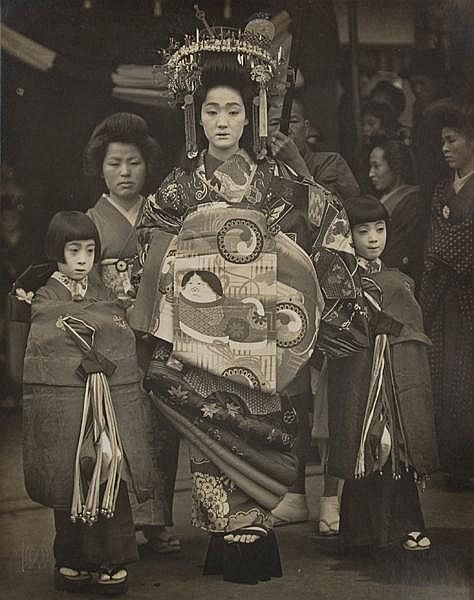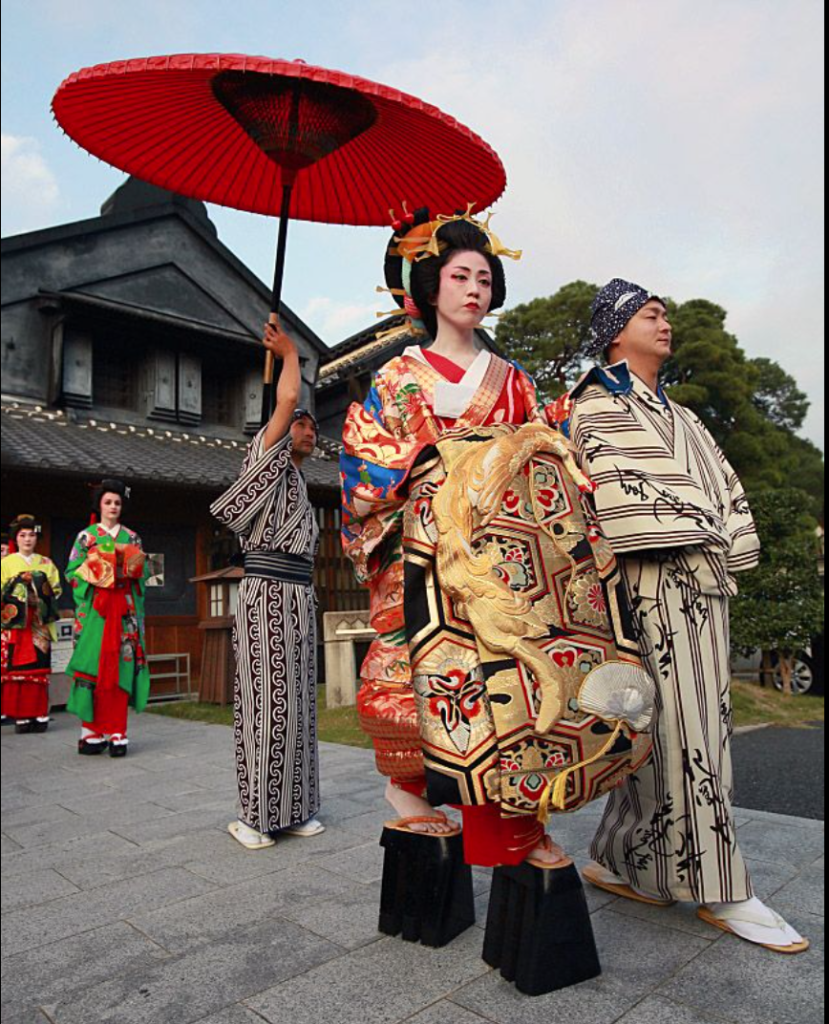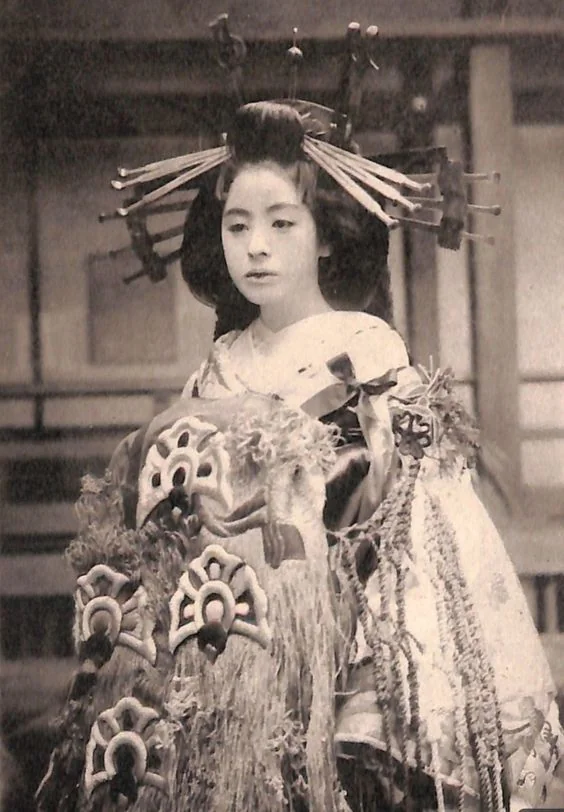Oiran and Geisha are often mistaken for one another due to their elegant appearances and connections to Japan’s historical entertainment culture. However, they are profoundly different figures. While geisha, the refined entertainers of traditional arts, continue to exist today, Oiran—the high courtesans of Japan’s Edo period—belong to a bygone era. Known for their opulent fashion, exceptional skills, and ceremonial processions, oiran once held a unique and revered position in Japan’s red-light districts.
Geisha vs. Oiran
Both iconic entertainers
Oiran and Geisha were expected to match their high-level clients in intellect and elegance.
To become the best entertainer, they both underwent rigorous training in traditional arts from a young age.They had to be well versed in the traditional arts of singing, classical dance and music. Their training also encompassed chadō (Japanese tea ceremony), ikebana (flower arranging), and calligraphy.
Their wit, intellect, and mastery of conversation made them more than mere companions. They were cultural icons, entertainers celebrated in ukiyo-e woodblock prints and kabuki theater.
…but in very distinct worlds
However, unlike Geisha, who focused solely on entertainment, Oiran were also high-ranking courtesans who combined their roles as artists, entertainers, and companions to Japan’s elite. Emerging from the yūjo (prostitutes) of the Edo period, they were the pinnacle of sophistication within the pleasure quarters (yūkaku), such as Yoshiwara in Edo (modern Tokyo). Their clientele consisted of wealthy merchants, samurai, and nobles, and their services were notoriously exclusive and expensive.
Oiran, who stayed exclusively within the pleasure quarters, became symbols of old-world elegance and formality, while Geisha epitomized modern companionship. Their simpler attire, accessible charm, and lighter repertoire resonated with a changing society, gradually overshadowing the oiran’s ceremonial grandeur.
The Fashion of Oiran: Walking Works of Art
Flamboyant Trend-Setters
The Oiran’s attire had to reflect her status and aesthetic sensibilities as well as the upper-class tastes and expectations of her customers:

- Kimono: Oiran wore flamboyantly colored kimono with intricate gold patterns. High-ranking courtesans donned furisode (long-sleeved kimono), their weight often exceeding 30 kilograms, requiring assistance to wear.
- Obi: The manaita obi, tied at the front, was practical yet ornamental, showcasing the wealth of clients and the vanity of the oiran.
- Accessories: Their waxed wigs, weighing up to 10 kilograms, were embellished with an array of kanzashi made from precious materials.
- Footwear: Koma-geta elevated them both literally (up to 20cm) and figuratively, enhancing their visibility and grace. One distinctive feature of the Oiran was their bare feet. Indeed, a bare foot against a lacquered clog was considered to be erotic, leaving the toes poking out under many layers of elaborate and flashy kimono.
- Makeup: Their faces were painted white with oshiroi, a traditional foundation, and only the lower lip was colored, symbolizing refinement.
Find out where to find your complete kimono set thank to our comprehensive guide to the best vintage stores!
The Oiran Douchu: A Spectacle of Elegance
The Oiran douchu, or courtesan procession, was a mesmerizing ritual that showcased the grandeur of an Oiran. The event began with dancers and musicians wearing fox masks—a nod to Inari, the patron deity of the Yoshiwara pleasure district. They played flutes, drums, and bells, filling the air with lively rhythms.
Following them were the kanabo hiki, watchmen carrying iron staves topped with jingling rings, signaling the procession’s arrival. Next came the tekomai, women dressed as men, embodying strength and masculinity. Along them, the chochin mochi, who carried lanterns inscribed with the oiran’s name.

The procession’s climax was the oiran herself, surrounded by young attendants (kamuro) in matching red kimono. Adorned in vividly colored, intricately layered silk garments, Oiran were visions of artistry and luxury. Her obi, a flat, intricately embroidered sash tied at the front, symbolized her courtesan status. Her hair, styled into an elaborate waxed arrangement, featured kanzashi—ornate hairpins made of tortoiseshell, coral, and gold.
Walking in koma-geta—towering 20-centimeter wooden clogs—the Oiran performed the soto hachi monji. This figure-eight walking style demanded precision and grace, as the Oiran would swing one foot out and around in a figure eight motion with each slow, small step.
Assisted by two manservants (known as wakaimono) to ensure balance, each step was a testament to her poise as her slow, deliberate movements captivated the gathered crowds.
The Legacy of the Oiran
The rise of Geisha in the late 18th century marked the decline of the Oiran. As the first adapted to contemporary tastes, Oiran became increasingly isolated, their traditions rigid and outdated. By the late Edo period, they had vanished, leaving behind a legacy of elegance, artistry, and a vivid snapshot of Japan’s cultural history.
Today, the Oiran douchu is reenacted as a cultural event, preserving the memory of these remarkable women. Through their striking appearances in art and performance, Oiran remain enduring symbols of beauty, grace, and sophistication—reminders of a time when they reigned as the queens of the pleasure quarters.
![[NANIKA]](https://nanikajapan.com/wp-content/uploads/2024/10/cropped-NANIKA-LOGO-transp.png)

Leave a Reply